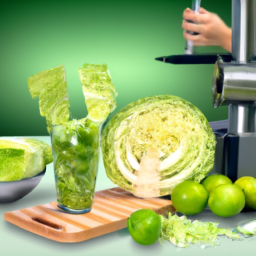As someone who values their health and is always looking for ways to improve their diet, I often wonder about the number of calories in the foods and drinks I consume. This curiosity is especially strong when it comes to green juice, a beverage that has gained popularity lately due to its many health benefits.
In this article, I will explore how many calories are in a typical green juice, as well as factors that can affect its calorie count. Green juice is made up of a variety of fruits and vegetables, including leafy greens like spinach and kale, as well as fruits like apples and oranges.
It is often touted as a nutrient-dense drink that can help promote weight loss, boost energy levels, and improve overall health. However, one question that often arises is how many calories are in a typical green juice. While the answer can vary depending on the recipe and ingredients used, understanding the calorie content of green juice can be an important factor in maintaining a healthy diet.
Key Takeaways
- The calorie count of green juice varies depending on the ingredients and serving size.
- Portion control is important to avoid consuming too many calories.
- Using low-calorie vegetables like spinach, kale, cucumber, celery, and parsley can make a low-calorie green juice.
- Sugar content can be high, so it’s important to focus on using more vegetables and fewer fruits in the juice.
Understanding the Components of Green Juice
Let’s take a closer look at what goes into making a delicious and nutritious green juice. Juicing methods vary, but the most common ones include cold press, centrifugal, and masticating.
Cold press juicing is the most popular method because it extracts juice without heat, ensuring that the nutrients are not damaged. Centrifugal juicing, on the other hand, is a faster method that uses a high-speed blade to extract juice. Masticating juicing is the slowest method that works by grinding and pressing the juice out of the produce.
Green juice is a great source of vitamins, minerals, and antioxidants. It is made by blending green leafy vegetables such as spinach, kale, and celery with fruits like apples, pineapples, and bananas. The nutritional benefits of green juice are numerous; it helps to support digestion, boosts energy, and strengthens the immune system.
Green juice is also low in calories, making it an excellent option for those who are watching their weight. However, it’s essential to keep in mind that the calorie count can vary depending on the ingredients used.
As we delve deeper into understanding the components of green juice, it’s essential to note the importance of calorie counting.
The Importance of Calorie Counting
Counting calories is like keeping track of the fuel that goes into your car, ensuring it runs smoothly and efficiently. The importance of calorie counting can’t be overstated. It’s a crucial aspect of maintaining a healthy lifestyle. Here are some benefits of calorie counting:
-
Accountability: Keeping track of your calorie intake ensures you’re aware of what you’re putting into your body, making you more accountable for your choices.
-
Weight loss: Calorie counting is an effective tool for weight loss. By monitoring your calorie intake, you can create a calorie deficit, leading to weight loss.
-
Portion control: Calorie counting also helps with portion control. It allows you to keep track of how much you’re eating, ensuring you don’t overeat.
-
Nutrient-dense choices: Calorie counting encourages you to make nutrient-dense choices. You’re more likely to choose foods that are low in calories but high in nutrients, such as fruits and vegetables.
The importance of calorie counting can’t be overstated. It’s a tool that can help you achieve your weight loss goals, improve your overall health, and make better food choices. In the following section, we’ll discuss the average calorie content of green juice.
Average Calorie Content of Green Juice
If you’re looking for a healthy beverage option, check out the average calorie content of a popular green drink. Green juice is a low-calorie beverage that’s packed with nutritional value. The calorie density of green juice is typically low because it’s made up of mostly water and vegetables.
On average, an 8-ounce serving of green juice contains around 50-70 calories. In addition to being low in calories, green juice is also high in nutritional value. It’s a great source of vitamins and minerals, including vitamin C, vitamin K, potassium, and iron. Green juice is also rich in antioxidants, which can help protect the body against diseases such as cancer and heart disease.
Factors such as the type and amount of vegetables used, as well as any added fruits, can affect the calorie count of green juice.
Factors That Affect Calorie Count
When it comes to the calorie count of green juice, there are several factors that can affect it.
The serving size of the juice can greatly impact the calorie content, as can the types of fruits and vegetables used.
Additionally, any additional ingredients added to the juice can also contribute to the calorie count.
By understanding these factors, you can make informed decisions about the nutritional value of the green juice you consume.
Serving Size
You’ll want to take a close look at the serving size of your green juice to get an accurate idea of the calories you’ll be consuming. Calorie estimates can vary greatly depending on the amount of juice you drink. To give you an idea of how serving size can affect calorie count, take a look at this table:
| Serving Size | Calorie Count |
|---|---|
| 8 oz (1 cup) | 80-100 |
| 12 oz (1.5 cups) | 120-150 |
| 16 oz (2 cups) | 160-200 |
As you can see, portion control is key when it comes to consuming green juice. It’s easy to overdo it and consume too many calories if you’re not paying attention to the amount you’re drinking. So, be mindful of the serving size and adjust accordingly to meet your calorie goals.
Moving on to the next subtopic, the type of fruits and vegetables used in your green juice can also affect its calorie count.
Type of Fruits and Vegetables Used
The variety of fruits and veggies in your blend can significantly impact the nutritional value, with some combinations containing up to 100% of your daily recommended intake of vitamin C.
Green juice taste can vary depending on the type of fruits and vegetables used, but typically it has a refreshing and slightly sweet taste.
It’s best to drink green juice in the morning on an empty stomach, as this allows for better absorption of nutrients.
Adding additional ingredients, such as ginger or lemon, can enhance the taste of your green juice while also providing additional health benefits.
Ginger can help with digestion and reduce inflammation, while lemon can boost your immune system and aid in detoxification.
These ingredients can be added in small amounts to complement the flavors of the fruits and vegetables in your blend.
Additional Ingredients
To enhance the taste and health benefits of your blend, consider adding ginger or lemon in small amounts. These ingredients not only add a zesty flavor to your juice, but also provide additional health benefits.
For example, ginger has been known to relieve nausea and reduce inflammation, while lemon is high in vitamin C and can aid in digestion.
There are numerous juice recipes available, and incorporating additional ingredients can make them even more nutritious. Adding herbs such as parsley or cilantro can help detoxify the body, while adding a small amount of cayenne pepper can increase metabolism.
Experimenting with different fruits and vegetables can help you find the perfect blend of flavors and health benefits. When making a low-calorie green juice, it’s important to choose ingredients that are low in sugar and high in nutrients.
Incorporating leafy greens such as kale or spinach and limiting the amount of fruit used can help keep the calorie count low. In addition, using water or unsweetened almond milk as a base instead of fruit juice can also help reduce calories.
Tips for Making a Low-Calorie Green Juice
Making a low-calorie green juice can be a healthy choice, as it could contain only about 50-100 calories per serving. To make a low-calorie green juice, I recommend using vegetables that are naturally low in calories such as spinach, kale, cucumber, celery, and parsley. Using fruit in your green juice can add unnecessary calories, so it’s important to stick to vegetables if you’re looking to make a low-calorie option.
Juicing equipment can also play a role in the calorie count of your green juice. Centrifugal juicers tend to produce juice with more pulp, which means more fiber and fewer calories. On the other hand, masticating juicers produce less pulp and therefore, a smoother juice that may contain slightly more calories. It’s important to consider your taste preferences when choosing your juicing equipment, but keep in mind that a low-calorie green juice can still be delicious and satisfying.
A low-calorie green juice can have many benefits for your health. Not only can it help you maintain a healthy weight, but it’s also packed with vitamins, minerals, and antioxidants to support your overall wellbeing.
The Benefits of Low-Calorie Green Juice
You can reap the rewards of a low-calorie green juice by incorporating it into your daily routine, boosting your nutrient intake and supporting your overall health.
Low carb options like kale, cucumber, and celery are great choices for a low-calorie green juice. These vegetables are nutrient-dense and provide essential vitamins and minerals like vitamin C, vitamin K, and potassium.
Aside from being low in calories and carbs, green juices also offer a plethora of health benefits. They can help lower inflammation, improve digestion, and support healthy skin. The high amount of antioxidants in green vegetables also provide protection against free radicals, which can cause damage to our cells.
Incorporating a low-calorie green juice into your daily routine is an easy way to improve your overall health and wellbeing.
In the next section, we’ll discuss how to incorporate green juice into your diet seamlessly.
How to Incorporate Green Juice into Your Diet
Incorporating green juice into your diet can be as simple as adding a few leafy greens to your morning smoothie or swapping out sugary drinks for a refreshing vegetable blend. Green juice recipes are abundant, and you can experiment with different blends to find the taste that best suits your palate. The benefits of drinking green juice are numerous, including improved digestion, increased energy, and clearer skin.
To make it easier to incorporate green juice into your diet, here are three tips to get started: First, start with a simple recipe that includes only a few ingredients. Second, make a batch ahead of time and store it in the fridge for a quick grab-and-go option. Third, try to drink your green juice on an empty stomach to maximize its nutritional benefits.
By incorporating green juice into your daily routine, you can improve your overall health and well-being. However, it is important to note that green juice should not be used as a replacement for whole fruits and vegetables in your diet.
Other Health Considerations
When it comes to incorporating green juice into my diet, I also consider other health aspects beyond calorie intake.
For one, I pay attention to the sugar content of the green juice, as some fruits and vegetables used in juicing can be high in natural sugars.
Additionally, I strive to maintain a nutrient balance in my diet, and while green juice can provide a boost in vitamins and minerals, it shouldn’t replace whole foods entirely.
By being mindful of these factors, I can ensure that green juice is a beneficial addition to my overall health and wellness routine.
Sugar Content
Did you know that green juices can be high in sugar content due to the natural sugars found in fruits and vegetables? While these natural sugars can provide a quick burst of energy, consuming too much can lead to a spike in blood sugar levels and cause health problems in the long run.
To reduce sugar content in your green juice, it’s important to focus on using more vegetables and fewer fruits. Vegetables such as kale, spinach, and cucumber are low in sugar and high in nutritional value, making them ideal ingredients for green juices.
Reducing sugar content in your green juice can help you maintain a healthier diet and prevent health problems associated with high sugar intake. However, it’s important to remember that nutrient balance is also crucial in creating a healthy green juice.
In the next section, we’ll explore how to achieve a balanced nutrient profile in your green juice by incorporating a variety of ingredients.
Nutrient Balance
To create a balanced and nutritious green juice, you should aim to include a variety of ingredients that are nutrient-dense and can help balance your macros. Nutrient density refers to the amount of nutrients per calorie in a food, which means that higher nutrient density foods provide more essential vitamins and minerals per calorie. Balancing macros refers to including the right amount of carbohydrates, proteins, and fats in your juice to support your body’s needs.
One way to achieve nutrient balance in your green juice is by incorporating a variety of fruits and vegetables. For instance, leafy greens like kale and spinach are rich in vitamins A, C, and K, while fruits like apples and berries are high in fiber and antioxidants. To help you get started, here is a table that lists some nutrient-dense ingredients you can add to your green juice:
| Ingredient | Nutrients | Benefits |
|---|---|---|
| Spinach | Vitamins A, C, K, folate, iron | Promotes healthy skin and bone health |
| Kale | Vitamins A, C, K, calcium, potassium | Supports heart health and reduces inflammation |
| Celery | Vitamins A, K, folate, potassium | Helps regulate blood pressure and improves digestion |
| Cucumber | Vitamins K, C, potassium | Hydrates the body and supports healthy skin |
| Pineapple | Vitamin C, manganese, bromelain | Reduces inflammation and aids digestion |
By incorporating nutrient-dense ingredients and balancing your macros, you can create a green juice that is not only delicious but also packed with essential vitamins and minerals. Now, let’s move on to some green juice recipe ideas that you can try at home.
Green Juice Recipe Ideas
You can easily incorporate more nutrients into your diet by trying out different green juice recipes, like the one that packs a whopping 250% of your daily recommended intake of vitamin C!
When it comes to flavor combinations, the options are endless. One of my personal favorites is a combination of kale, spinach, cucumber, celery, lemon, and ginger. The kale and spinach provide a hearty dose of vitamin K, while the cucumber and celery add a refreshing crunch.
If you’re new to juicing, investing in a high-quality juicer can make a big difference in the quality of your juice. I recommend looking for a juicer that has a slow masticating process, as this helps to preserve the nutrients in the fruits and vegetables. Some popular juicer recommendations include the Omega J8006HDS and the Breville JE98XL.
Remember to always wash your produce thoroughly before juicing, and to use organic whenever possible to avoid consuming pesticides and other harmful chemicals.
Frequently Asked Questions
Can green juice be a replacement for a meal?
As a nutritionist, I can say that green juice can be a healthy addition to a meal, but it shouldn’t replace a meal entirely. While it offers benefits like high nutritional value, drawbacks include low calorie count and lack of satiety.
How does the calorie content of green juice compare to other types of juice?
When comparing juice calorie content, green juice typically has fewer calories than fruit juices. However, the nutritional value of green juice is higher due to its abundance of vitamins, minerals, and antioxidants.
Is it better to drink green juice in the morning or at night?
When it comes to drinking green juice, there are potential digestive benefits to drinking it in the morning. However, drinking it at night may disrupt sleep due to its high fiber content.
Can green juice help with weight loss?
As the saying goes, "you can’t outrun a bad diet."While green juice may aid in weight loss as part of a juice cleanse, it’s important to note that long-term results depend on overall nutrient absorption and a balanced diet.
How long does it take to see the health benefits of drinking green juice?
I’ve found that it can take anywhere from a few days to a few weeks to start experiencing the health benefits of drinking green juice. The juice cleanse can aid in the detoxification process and lead to improved digestion, clearer skin, and increased energy levels.
Conclusion
In conclusion, green juice can be an excellent addition to a healthy diet, but it’s important to be mindful of its calorie content. By understanding the components of green juice and factors that affect calorie count, you can make informed choices when making or purchasing a green juice.
Imagine starting your day with a refreshing green juice that not only nourishes your body with essential vitamins and minerals but also keeps your calorie intake in check. With a little creativity, you can make delicious low-calorie green juice recipes that suit your taste preferences and dietary needs.
So, go ahead and incorporate green juice into your diet, and reap the numerous health benefits it has to offer.
Ilana has been a vegan for over 10 years. She originally made the switch for health reasons, but soon found herself becoming more and more passionate about the ethical and environmental implications of a vegan lifestyle. Ilana is the author of The Graceful Kitchen, a blog all about veganism. She loves to cook up delicious and nutritious vegan meals, and share her recipes with others who are interested in leading a cruelty-free life. Ilana is also a strong advocate for using whole foods as the foundation of a healthy diet, and believes that going vegan is one of the best ways to achieve this.
















